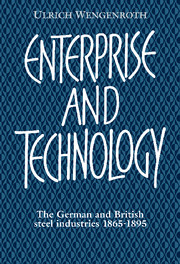Book contents
- Frontmatter
- Contents
- List of figures
- List of tables
- Preface
- List of abbreviations
- Introduction
- 1 The technology of late nineteenth-century steelmaking
- 2 Expanding into the Slump: the railways as major customers of the new steel industry
- 3 Surmounting the Slump: the individual strategies of firms
- 4 Surmounting the Slump: collective strategies
- 5 New processes and new markets
- 6 Efficiency and capacity for innovation
- Sources and bibliography
- Index
6 - Efficiency and capacity for innovation
Published online by Cambridge University Press: 18 January 2010
- Frontmatter
- Contents
- List of figures
- List of tables
- Preface
- List of abbreviations
- Introduction
- 1 The technology of late nineteenth-century steelmaking
- 2 Expanding into the Slump: the railways as major customers of the new steel industry
- 3 Surmounting the Slump: the individual strategies of firms
- 4 Surmounting the Slump: collective strategies
- 5 New processes and new markets
- 6 Efficiency and capacity for innovation
- Sources and bibliography
- Index
Summary
Entrepreneurial decline and steel: the British debate
The question about enterprise strategies and technical progress in the German and British steel industry must in the end refer to the assessment of the relative efficiency and capacity for innovation of these two industries, including the entrepreneurs who ran them. While the technical competence and managerial ability of the German steel industrialists was never in doubt and the discussion was primarily sparked off by the political consequences of their dominant position in the Reich, their British colleagues were subjected to occasionally destructive criticism and were made partly responsible for Great Britain's gradual loss of her hegemony around the turn of the century. The different structures of the German and British steel industries, whose development has been studied in this book, have led to the conclusion that, by the late nineteenth century, there was a successful German way based on the Thomas process and the use of poor, domestic iron ores. The origins of the British steel industrialists' tendential decline lay in their failure to follow this successful model, which is attributed solely to incompetence on the part of British entrepreneurs. This orthodox picture was subjected to a fundamental revision by McCloskey at the beginning of the 1970s, which gave a strong boost to the debate about ‘entrepreneurial decline’ in Great Britain. Before we undertake a comparative assessment of the efficiency and capacity for innovation of the German and British steel industrialists on the basis of our preceding research, we intend to make a critical analysis of the positions adopted by the two most important antipodes of this debate: Burn and McCloskey.
- Type
- Chapter
- Information
- Enterprise and TechnologyThe German and British Steel Industries, 1897–1914, pp. 247 - 273Publisher: Cambridge University PressPrint publication year: 1993

